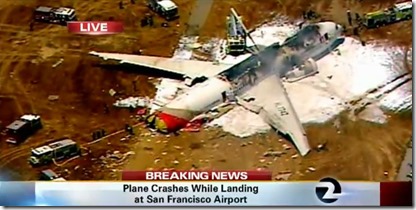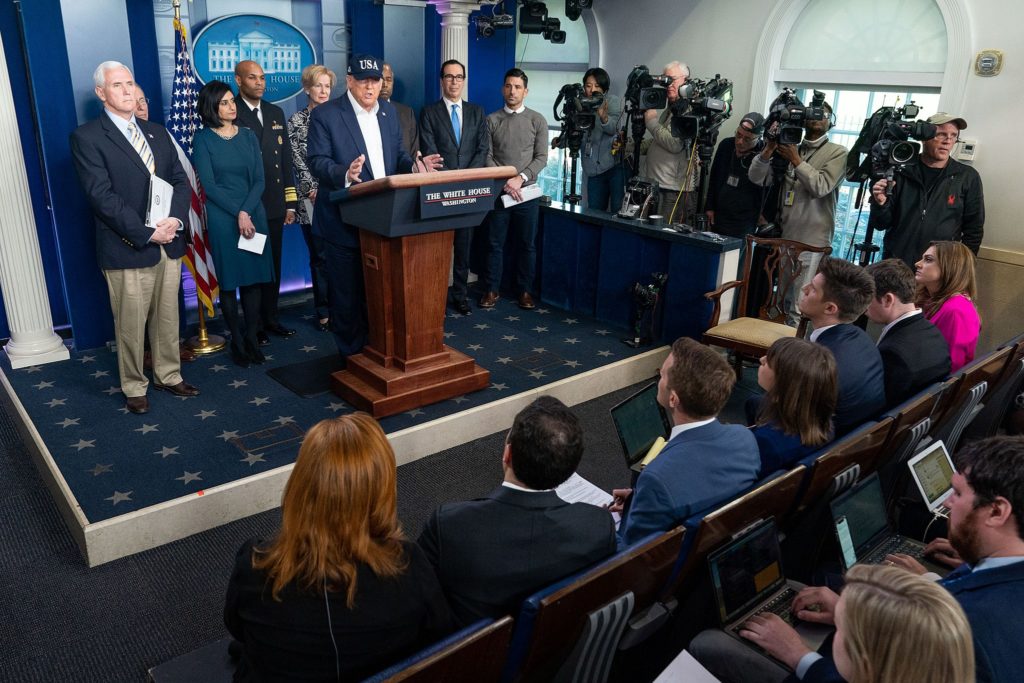Asiana Airlines: An Unsympathetic Press Release
Almost six hours after an Asiana Airlines flight crashed upon landing at San Francisco International Airport today, the airline finally posted a press release about the incident to its website and Google+ page.
Considering that at least two people are confirmed dead and at least 40 more were badly injured, you might have thought that the airline would have offered an expression of sympathy to its passengers, as well as to affected family members and friends. After all, one of the seven rules of a crisis is to align your communications with any victims.
But it didn’t. Instead, the press release reads as a cold recitation of facts.
Asiana Airlines flight OZ214 (Aircraft Registration HL7742) departed Incheon International Airport on July 6, 2013 at 16:35 (Korea time) bound for San Francisco. Only July 7, 2013 at 11:28 (Local time) an accident occurred as OZ214 was making a landing on San Francisco International Airport’s runway 28.
There were a total of 291 passengers (19 business class, 272 travel class) and 16 cabin crew aboard. The majority of the passengers were comprised of 77 Korean citizens, 141 Chinese citizens, 61 US citizens, 1 Japanese citizen, etc. for a total of 291 people.
Asiana Airlines is currently investigating the specific cause of the incident as well as any injuries that may have been sustained to passengers as a result. Asiana Airlines will continue to cooperate fully with the investigation of all associated government agencies and to facilitate this cooperation has established an emergency response center at its headquarters.
At this point no additional information has been confirmed. New developments will be announced as more information becomes available.
You might think that the airline didn’t comment on the victims intentionally to avoid increasing the odds of litigation. Not only would that be flawed thinking on the airline’s part (an expression of sympathy is generally not regarded as an admission of guilt), but it also ignores one curious fact: the airline had already posted a tone-perfect statement on its Twitter feed:
The problem is that more people are likely to encounter Asiana’s official press release than its earlier tweet; this sentiment should have been included in their press statement. The airline surely has a crisis communications plan in place – and any template press release for an accident should have automatically included that language.
The airline’s first press release is missing a critical piece. But it’s not too late to update it with the focus in the right place—on the victims—and should do so immediately.
Finally, to the commenter on my Twitter feed who suggested that cultural differences may be at fault here, that’s not an excuse. An international company should have a crisis communications plan in place that adheres to the best practices of each of the countries it serves.
For more, read my recent post, “In a Crisis, The Media Will Side With The Victims.”
UPDATE, JULY 6, 2013, 11:00 P.M.
A train derailed in Quebec today, resulting in numerous fatalities. The railroad’s crisis response strikes a better tone, and stands in marked contrast to the response from Asiana Airlines. Here’s an excerpt from their release:
“MMA management and employees are devastated at this news. We extend heartfelt condolences to those residents of Lac – Mégantic who have lost their homes and businesses, and particularly those who have suffered injuries and lost loved ones. We intend to have representatives on site as soon as possible to lend assistance to the community and to deal with individual issues coming out of this disaster.”
Note: Although MMA got that paragraph right, many people are criticizing MMA for waiting until the fifth paragraph in their press release before expressing sympathy to the victims, underscoring the need to put victims above all else.
UPDATE: JULY 7, 2013, 9:30 A.M.
Asiana Airlines released a new statement this morning; the first paragraph put the focus on the victims:
“We at Asiana Airlines would like express our utmost sympathy and regret for the distress experienced by the passengers of OZ flight 214 and their families as a result of this accident. We apologize most deeply.”
The release also says “Asiana Airlines has established emergency response centers to ascertain the cause of this crash and to look after injured passengers and contact their families.” Imperfect syntax aside, this release is much better than last night’s, and puts the company’s public focus where it should be–on the victims. This is a good reminder to companies that in a crisis, the victims must come first.
Note: A woman who says her brother was on the flight was upset with this post. You can read our exchange in the comments section.
Have the best of the blog delivered to your inbox twice per month! Enter your name in the box below to join our mailing list.





This does nothing to help the traumatic situation right now and all your’re doing is simply pointing the finger and making blunt, unneccessary accusations and completely undermining the Asiana staff who are working tirelessly for the passengers and their families. My brother was on this flight and I am consistently receiving personal updates from Asiana Airlines and I much rather they focus on alerting the passengers and their families than writing up “sympathetic” press releases just for curious onlookers like you… Disgusted and disasppointed. Have some respect for those invovled first hand.
Dear Helen,
First and foremost, I hope your brother is okay and that you and your family are having the opportunity to reconnect with one another. I’m sorry for the trauma you and your loved ones are going through, and send every positive thought your way. I’m thrilled to learn from you that the airline is communicating well you.
This blog’s reason for being is to analyze media and crisis responses. Given your personal and positive experience with the airline, I wish that much more that their public response matched their private one. As for a “sympathetic” press release, focusing a public response on the concerns and needs of the victims is an industry best practice, and for good reason. The first press release issued by a company is their best chance to tell the world, “This is who we are, these are the values we stand for, and this is what’s most important to us.” Emphasizing the victims in a press release sends a strong message to victims and the public that the company is more concerned about helping victims than preserving their own bottom line. Companies that neglect that detail often face a longer road to recover their reputations; think of Exxon or British Petroleum as examples. And you’re right that they shouldn’t be spending their time doing that now – most companies do that work in advance, since these types of accidents, while obviously tragic, are also predictable.
Again, I wish you and your family all the best.
Sincerely,
Brad Phillips
I don’t disagree with you – yes a company needs to have a strong initial press release but if you haven’t already seen on local, national and international news, not even the authorities have completely uncovered the situation and only just five minutes ago, the gender of the two deceased was discovered. The brief and yes, very shallow press release by Asiana, would be flawed if it was written a while after the incident, but to shame and deface them in such premature stages of the accident (not even a day has passed) is what I disagree with, and what has so far been posted, is really all that can be done at this stage. Reasonably, what more can be done when not even authorities are a hundred percent definite with the entire situation? From what I’ve read of their press release, it is objective, succint and to the point with every detail covered. Yes, whilst it lacks sympathy, the sympathy doesn’t have to be shown in a press release to confirm they are sympathetic. Who wouldn’t be in a time like this? From my experience, it seems Asiana are more focused on action rather than words and they are getting things done and fixing the issue at hand rather than trying to maintain reputation, after all, actions really do speak louder than words. This I believe is the real factor in maintaining a reputation and really proves their values that doesn’t have to be shown in a press release to be proved.
Thank you for your thoughtful reply, Helen. You make some very valid points, so rather than address each of them, I’d only add three thoughts:
1. You’re right that a company managing a crisis doesn’t know all of the facts at the beginning of a crisis. No one should expect them to (I certainly don’t). The best communications practice during a crisis is to communicate what you do know (in this case, the fact that there were injuries was known early, so a statement that expressed concern wouldn’t have been premature) and convey your commitment to sharing more as soon as you learn it.
2. In most companies, especially large ones like an airline, press releases for the most obvious potential crises are drafted in advance. If and when the crisis actually occurs, the communications team generally plugs in the details of the incident to a preexisting template. That template should have had something in it about emphasizing their deep commitment to serving the people most affected by the incident.
3. The biggest point I’d make, based on your own personal experience with the airline, is that I wish their public response matched the private one you received. You may be right that the company’s PR will catch up to them (in other words, that the quality of the private response you and others received will become better known when victims’ families speak, which will help the company maintain or recover their reputation long-term). But that’s a risk. The media will likely cover this story for a short time, during which the majority of the company’s crisis response will have already cemented in the public’s mind. I would maintain that they should be and could be focusing on delivering the best possible private and public response – not one or the other.
When this incident is over and your family has settled back into a more normal routine, I’d welcome the chance to speak with you to hear more of your first-hand perspective. I’m always open to learning from smart people, especially smart people who have been at the center of the incidents I’ve written about.
Again, all the best to you and your family.
Brad
Helen above must be a huge fan of the airline company. 🙂 You can find her many nice comments on THE airline’s SNS channels. Just interesting…it is Korean style.
Brad. I totally agree with your points as a professional. I must say this. Cheers!
Thanks very much for reading, James! I’m glad you found the points relevant.
Appreciate your comment,
Brad
@ James Chung: Yes I like to compliment and speak well of companies who know how to run their business for their customers and value their customers especially during difficult times.
@Brad: All your points are valid and highly professional, and after reading the updated press release from Asiana, I can clearly see the stark differences between their first release and the latter one, though I’m still not sure I can agree with accusing them as “unsympathetic” at a juncture that was very premature and traumatic. Yes the company’s initial press release was brief and objective, and certainly could/would have been better had they pre-prepared but pinpointing a minor flaw and accusing them of it doesn’t particularly help the company’s image either. Evidently below, and at an appropriate time, the company has issued a more comprehensive and “sympathetic” release.
Official Asiana Statement from OZ214 Incident Press Conference
2013-07-07 16:31
We at Asiana Airlines would like express our utmost sympathy and regret for the distress experienced by the passengers of OZ flight 214 and their families as a result of this accident. We apologize most deeply.
Asiana Airlines flight OZ214 departed Incheon International Airport on July 6, 2013 at 16:35 (Korea time) bound for San Francisco. On July 6, 2013 at 11:27 (Local time) an accident occurred as OZ214 landed on San Francisco International Airport’s runway 28.
A total of 291 passengers were aboard the aircraft. (77 Koreans, 141 Chinese, 64 Americans, 3 Indians, 3 Canadians, 1 French, 1 Japanese and 1 Vietnamese)
Asiana Airlines has established emergency response centers to ascertain the cause of this crash and to look after injured passengers and contact their families. Asiana continues to actively cooperate with all Korean and US governmental institutions in the ongoing investigation.
Helen,
Thank you for sending the new press release – I’ve updated my post to give Asiana credit for getting it right in the second round.
Also, I take your point. In hindsight, I could have chosen a word other than “Unsympathetic” for the title, such as “Imperfect.” That would have softened it a bit without losing my larger point.
Thank you for interacting with such thoughtfulness. You’ve made your points well.
Best wishes,
Brad
As long as I know, first press release of Asiana airline was based on their own earlier situation analysis result. They believed there was no actual casualty from the incident until this morning (Korean time), so they said it to the media without any sympathy.
But San Francisco government announced actual casualties later and the airline changed their position with the information. That is why the first sympathy communication was just released at late afternoon when the airline company CEO held belated press conference. (CEO was not in Korea in this morning…)
Please note. 🙂
James,
Thank you for your comment.
Even without knowledge of casualties or fatalities, the first statement should have been victim-focused. At the very least, the airline knew that many of its passengers were likely traumatized and would have to change their travel plans. A simple statement of intent, such as “We will do everything possible to help those who have been affected by this incident,” would have gone a long way.
Thanks again for reading!
Brad
Exactly right and agree, Brad. This incident communication of the airline has a lot of weird aspects. The airline failed initial situation analysis on casualties, delivering their sympathy in initial stage (as we discussed), providing timely information what media and public wanted to know, and holding press conference in right time. I can say this is even totally different with ways of communication done by Korean Airline’s crash case in Guam in 1997. Many thing and fact are still uncovered. Nobody knows why they should do these…YET.
Thanks, Brad.
James
Hi Brad,
I think this is a fantastic article and the structured answers in the comments proves your ability to defend your reporting. However I would like to defend the Asiana Airlines slightly, by providing communication in English as it happened in the U.S where as although the response to Quebec was seen as better it was sent in English to a French speaking area, in your opinion which is better/worse. Also I would love to hear your thoughts on the difference in how the public facing Senior Representatives from both companies have faired in the media spotlight.
Many Thanks
James
James,
Terrific point – thank you for adding your comment/question to the blog.
My praise of the Montreal, Maine & Atlantic Railway’s communications was limited solely to its initial press release; specifically, I recognized that it appeared victim-focused. I did not take into account the language difference, and you raise a very good point that it should have been in the region’s primary language (or, better yet, in French and English).
Their communications since then have been a disaster. Look for more on this story toward the end of the month. I suspect this will be one of July’s worst media disasters…
Best wishes,
Brad
James,
What struck me with regard to the Quebec train disaster, was that company leadership publicly blamed the disaster on human error by a named employee – and announced that that employee had been sent on leave without pay.
A disaster like this will not be caused by a single human error. The events and circumstances that have led to the terrible outcome undoubtly show a more complex and subtle pattern.
In that context I am surprised that you picked this example of how company leadership may communicate publicly in response to a disaster.
Kind regards,
Nico